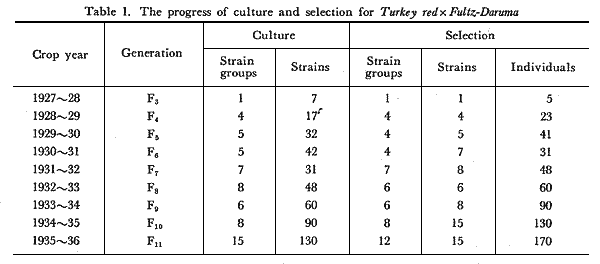The cross, Turkey red x Fultz-Daruma at the Ehime Prefectural Agricultural Experiment Station was originally made for the purpose of obtaining a line with rust resistance, early maturity and a short stem. Since Iwate Prefectural Agricultural Experiment Station was the local center of the northern regions of Honshu (main island of Japan), further emphasis was put on a higher cold and snow resistance. In the course of the breeding work, however, there appeared a special dwarf type, and therefore, efforts were made to select this dwarf type for practical purposes.
3) The experiments earried out during the early stages at the Konosu Agricultural Experiment Branch Station:
The project leaders in wheat experiment at the Konosu Branch Station at that time were Dr. Morimasa YAMAZAKI, and Mr. Susumu HATANO. The F2 breeds of Turkey red x Fultz-Daruma received from the Ehime Agricultural Experiment Station were cultured from 1926 and the selection was made in the following years. Consequently, from the selections, 7 strains of F3 (Kokei 881-887) in 1927, 12 strains of F4 (Kokei 1884-1895) in 1928, 9 strains of F5 (Kokei 3642-3600) in 1929, and 1 strain of F6 (Kokei 1892) in 1930 were sent to the Iwate Agricultural Experiment Station for local experiments.
4) Pedigree culture and further selection at the Iwate Agricultural Experiment Station:
The results are summarized in the following tables.

From 3 strains in the 12 Kokei1) strains of F4 received in 1928, dwarf plants segregated at about 10%. From Kokei 1895 were selected 5 individuals with a relatively high quality of cold and snow resistance (winter killing) including long (normal) and short (dwarf) stem plants. A dwarf strain of F5 showed small spike and poor filling of the grain, and therefore from a strain segregating for long, semi-dwarf and dwarf (Kokei 1895-8) were selected 35 individuals. Among 35 strains of F6 there were 5 strains of dwarf types, while from Kokei 1895-8-2 with longer spikes and better quality were selected 5 individuals. These 5 individuals became F7 and all 5 strains were of seim-dwarf types.
In 1932 the strain of F7 was named as Tohoku 34, and productivity as well as adaptability tests of this variety were then conducted not only in Iwate prefecture but also in neighboring Prefectures. The pedigree culture was continued until Kokei 1895-8-2-6-4 was selected from 5 strains of the F9. In 1935 this breed was named Norin 10 and registered at the Ministry of Agriculture and Forestry, as a recommended variety for the two northern Prefectures, Iwate and Yamagata. Since, however, there still appeared a small number of long stem plants (normal type), 50 strains were used for further experiments.